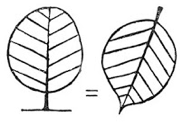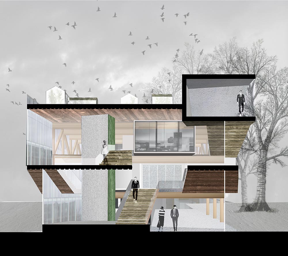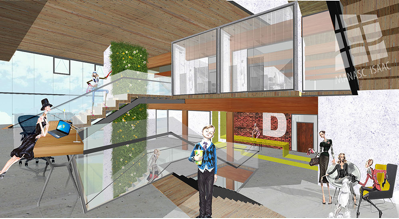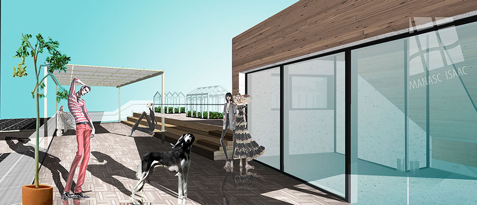BY VEDRAN SKOPAC
The Nature of Things
In order to live fully, we need to understand the profound and deep meaning of things, using all of our physical, mental and spiritual capacity of comprehension.
Architecture is no different. No matter what we think of it, or how much we agree or disagree on details, the big picture is as important as any impressive feat of human engineering or design. Thinking about the ‘why’ should be just as important—perhaps even more important—than the ‘what.’
Lately the catalyst for an evolution of ideas comes from a philosophy that current models are broken and in need of repair or abandonment entirely. We see this in our education, communication, technology, and energy consumption models, just to name a few. I would argue, however, that architecture has been slow to respond to the battle cry for change. Part of this, I believe, has to do with a manifestation of a pervasive ‘throw-away’ culture, particularly in North America. We build to fulfill a function rather than building to serve a purpose. Our need to build spaces in order to function will certainly never change, but the purpose behind why we do what we do needs to evolve if we hope to emerge intact from all the brokenness.
I believe a renaissance in the art of architecture is possible by way of new design that is more responsive to the social, economical, cultural and natural values of the environment.
Most of the artificial environments we’ve built so far do not resonate to the true nature of our beings. So much of our human experience—joy, pain, laughter, love, and loss—happens within a constructed space and, as such, these spaces should make us wonder, grow and thrive. We can truly flourish only if we are interested, inspired, feel autonomous, worthy and purposeful about things we’re doing. There is no reason why a building should be any less rich in its capacity to support a flourishing life.
I believe that in order to understand the nature of buildings, we need to understand our own nature first. We are not linear creatures that live by mechanical models inevitably produced by an industrial society. We can only live to our full potential in a more agricultural model where fewer things are imposed, more things left unfinished, and the diversity, dynamics and distinction of spaces in every building is as boundless as our imagination.

Aldo van Eyck, in his ‘Maison Reciprocity’ stated: “Tree is leaf and leaf is tree. House is city and city is house. A tree is a tree but it is also a huge leaf. A leaf is a leaf but it is also a tiny tree. A city is not a city unless it is a huge house. A house is a house only if it is also a tiny city.”
Tell Me a Story
Throughout our history there has been extraordinary evidence of the value in storytelling. Storytelling is what connects us to each other, our environment, and our past, present and future. The narratives we create speak to the deeper meaning of our experiences. In the past, cultures, religions, and disciplines like arts and sciences used stories as a primary medium of operation. Architecture is one of them. The buildings we create should tell a story of shared experience and connectivity, and continue to inspire the creative spirit. The story of architecture should read like a quest for purpose, reaching for the farthest heights of imagination.
I believe successful architecture takes you on a journey that is as unpredictable and absurd as everyday life and, at the same time, introduces new worlds and provides a platform for expression of our true nature.
Making the Connection
As our connection to other human beings is dynamic, such so too is our connection to our environment. We cannot thrive while we’re alone. We need to connect with each other, as well as our environment to mutually create things that are greater than our own imagination.
I believe we connect to our surroundings only when we embrace the following: 1) mastery in things we do, in order to feel good about the ‘way’ we do it; 2) the idea of non-conformity that unleashes our own originality, proving that human beings do not need to be micro- or macro-managed, but are perfectly capable to grow on their own terms as autonomous individuals; and 3) the deep and profound belief in something abstract and transcendental that we explain to ourselves as the core reason of doing anything in the first place. In other words, the purposeful meaning of things, the ‘why’ that resonates deep down with the part our nature that makes us so distinct from anything else we’ve ever encountered so far and presents an infinite human capacity to create.
My contention is that the most important goal of every human activity is to thrive, on a personal level, and as a global community. And I believe connectivity is the basis of all that helps us flourish. We are connected to each other, our history and shared knowledge, the environment, and the purpose that drives us to create. The most important bank we have, is the ‘bank of knowledge’. And the most effective way to share knowledge is by storytelling. Recently, it has been demonstrated that communities are more connected than ever before and the mental and spiritual growth of the human race is greater than we could have ever anticipated. Now is our time to flourish and reap the rewards of our shared bank of knowledge.
Returning to the natural order of things, architecture will experience renewed purpose and more dynamic connection. It’s time for architecture to write a new chapter in the book of its evolution.
So What about the Mosaic Centre Building?

We live and design by the principle that every building is an opportunity to serve our community by looking for ways to thrive in every possible way. We were fortunate to work with a client and a contractor who share a very similar system of values. Our desire to do good by serving others was not only tolerated, but we were encouraged and inspired to do even more.
Besides the usual values of creating a healthy and sustainable environment, we were asked to be mindful of the legacy this project intends to leave to the local and broader communities and to value teamwork while achieving these goals. We were literally asked not to work too hard, and to help each other even more than we would usually dare to do. It was a relieving feeling to be supported by a group of people who actually believe it’s important to enjoy your work, rather than to endure it. By having an innovative client who inspires us to spread our horizons, and a courageous contractor eager to explore new worlds, we know we’re setting ourselves up for an unforgettable journey.
As architects usually do, we had our own secret missions as well. That mission was to break the status-quo in current, readily applied scarce architectural typology for commercial buildings that does not allow for life to happen spontaneously. We wanted this building to be a rich and colorful ‘city’ with an intimacy and familiarity of a ‘tiny house’.
Here, I present some of those missions that I hope to be interesting enough to talk about.

Secret mission #1: A JOURNEY
The goal is for employees to never arrive at their work stations.
The idea of the workplace just received a new meaning. It is not defined by a sense of ownership of a certain spot in the building, or a piece of equipment. It is literally anywhere one can encounter another building user.
If we can’t influence the entire culture of a city, we surely can influence the culture of a building. The every-morning travel to work should be treated as a ritual where one prepares for a transition from the ‘temple of sleep’ to the ‘temple of work’. This is a very sensitive moment as every morning is a beginning of a ‘new life’.
There is no rational or irrational reason I could think of as to why this ritual should be identical, every morning one after another, year after year, until we retire. If we agree on the three principles mentioned earlier (mastery, autonomy and purpose), then we could probably imagine a work environment in which we’d let go of almost any kind of control and simply trust each and every individual to be capable of making the most valuable decisions on his/her own.
The hope is that this building will help create a culture that will inspire each individual and group to release the creativity that is oppressed somewhere deep down inside in our linear and conformant lives, and last but not least, tolerate the errors and imperfections made along the way.
Imagine a workplace where you ‘get lost’ (like Alice in Wonderland) on your seemingly predictable path from your car in the parking lot to your desk on one of the upper floors by being constantly engaged with unpredictable and unexpected worlds that stimulate your interests and imagination.
As you enter the building, you notice the floor level change and different groups of programs identified with each one of the arriving floor levels. Then, you notice children playing in the slightly sunken area, protected from the business of the rushed world. Some of the children are playing on the sunbathed terrace, on the same submerged level as the ‘children’s world’.
As you continue your way to the flights of stairs randomly scattered all over the most active, central part of the building, you pass by the restaurant and the breakfast bar that are encroaching the lobby the way farmers usually spread their goods at the farmer’s market; temporarily claiming the ‘public space’ for a while.
If you don’t see some of your colleagues doing morning yoga in the wellness centre, you’ll surely find some of them reading a book, texting, discussing, napping, or simply passing by the bleacher stairs, strategically tapered to focus on areas of higher activity, leaving some corners on the galleries more intimate for more solitary types of work.
Suddenly, you realize that you’re not the only one who is grumpy and unmotivated early in the morning, and that there are others hoping to be engaged with a less predictable scenario of their standard working day.
This concept is informed by recent research that finds attention deficit disorder in humans is caused by individuals not being able to express their true talents by being forced to engage with non-stimulative activities in highly controlled and over-designed environments.
We cannot predict what will happen or control the outcome if we let individuals wander and make more decisions on their own. But we know the current model is ‘broken’ and the only way to stimulate and inspire a human being is to create conditions by which life will flourish, similar to a farmer preparing the soil for plants to grow, not knowing or daring to expect any predictable outcome. It wouldn’t make much sense for a farmer to impose his own expectations for growth, especially without providing the necessary conditions (soil, water, light, etc.)—would it?!
At the end, you never arrived to your work station. Instead, you went through a variety of different experiences and made choices along the way. You’ve already had a chat with Tom from the upper floor, met with Eleanor and Jim to find out that there’s no reason to have that afternoon meeting you were so stressed about, and then you had an accidental breakfast meeting with Stuart who discovered a more effective way of doing the work you planned to do on your own in your lonely corner.
All of a sudden, you do not feel alone anymore; you realize that the capacity of the group far exceeds that of the individual, and you finally accept to be modified by the outer world and be part of something greater than yourself.

Secret mission #2: ‘THE ROOFTOP VILLAGE’
As it is already afternoon, you need a break in a remote spot. Finding your way through energy bursting worlds, up to the sunny rooftop terrace, you notice a group of people already there having an informal meeting under the shade of a trellis. Not wanting to interrupt the group as they cultivate their creative juices in the sunshine and fresh air, you continue to the upper level of the roof deck where you are surrounded by a village-like formation of greenhouses.
You’re taken aback by how different they look since the last time you saw them. The density of growth has changed; the in-between ‘streets’ are much narrower, crowded by green leaves, beautiful blooms and ripening fruit. Bees are busily alighting from one flower to the next. You’re awestruck by the simplicity and naturalness of it all. It only makes sense that this building culminates in the ability to create and grow—whether it’s a village of interconnected, like-minded people, or a village of greenhouses growing food on the roof, Mosaic Centre seeks to create opportunities for connectivity and purpose that ultimately, and naturally, lead to growth.
One other thing you’ve noticed about the village is that the ‘demand’ for occupying the rooftop ‘land’ is greater than its capacity. Even though density was the governing principle for rational use of the rooftop space, it appears that those cool greenhouses would occupy as much space as they have at disposal.
Given that occupants of Mosaic Centre will consider the ‘rooftop village’ to be an interesting idea, the hope is that by creating something that is appealing but limited at the same time; it will profoundly raise our awareness of limited natural resources and help protect our environment.
